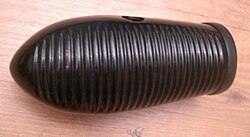Scraper (instrument)

Modern fibreglass Cuban güiro
|
|
| Percussion instrument | |
|---|---|
| Other names | Rascador, güícharo, candungo, carracho, rayo |
| Classification | Idiophone, could be made from wood, gourd, metal, plastic or fiberglass |
| Hornbostel–Sachs classification | 112.23 (Scraped idiophone, vessel) |
| Playing range | |
| Speed of scrape produces some variation | |
| Related instruments | |
| Güira, guayo, guacharaca, reco-reco, quijada, washboard | |
The güiro (Spanish pronunciation: [ˈɡwiɾo]) is a Latin American percussion instrument consisting of an open-ended, hollow gourd with parallel notches cut in one side. It is played by rubbing a stick or tines along the notches to produce a ratchet sound.
The güiro is commonly used in Puerto Rican, Cuban and other forms of Latin American music, and plays a key role in the typical rhythm section of important genres like son, trova and salsa. Playing the güiro usually requires both long and short sounds, made by scraping up and down in long or short strokes.
The güiro, like the maracas, is often played by a singer. It is closely related to the Cuban guayo and the Dominican güira, which are made of metal. Other instruments similar to the güiro are the Colombian guacharaca, the Brazilian reco-reco, the quijada (cow jawbone) and the frottoir (washboard).
The güiro, which was adapted from an instrument which might have originated in either South America or Africa, is a notched, hollowed-out gourd. The güiro is made by carving parallel circular stripes along the shorter section of the elongated gourd.
It is played by holding the güiro in the left hand with the thumb inserted into the back sound hole to keep the instrument in place. With the Brazilian güiro, after frictioning the springs it's possible to make use of the prolonged reverberation, or muffle them with the fingers. In some models, the box also has a bottom hole, allowing the musician to change the internal reverb by covering it or not.
Modern instruments found in Cuba now feature a square-shaped cut-out opposite of playing side in which to facilitate holding the instrument more comfortably.
...
Wikipedia
